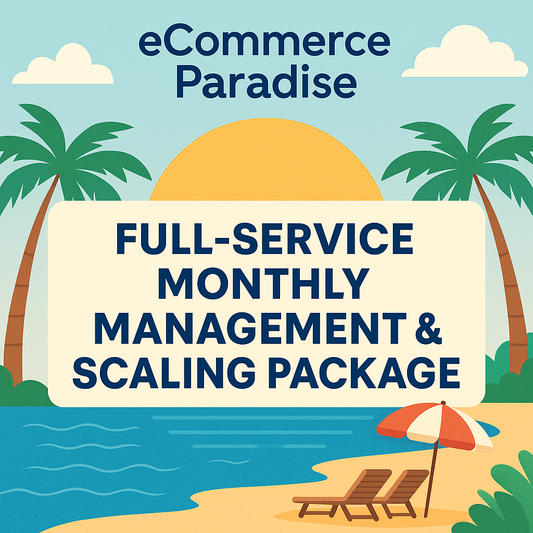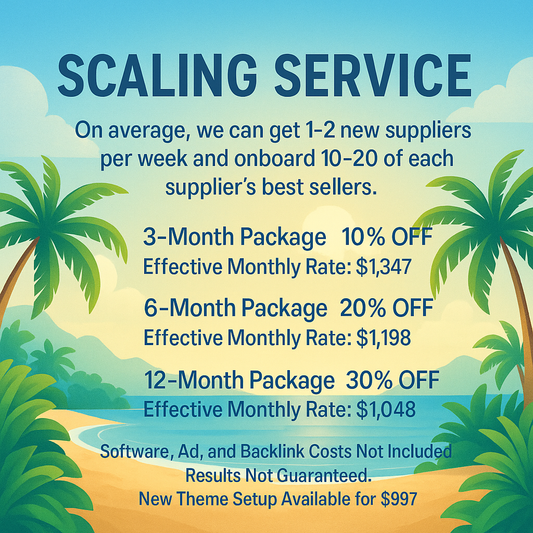
Navigating Google’s Algorithm Changes Like a Pro
Hello, friends! Trevor Fenner here from Ecommerce Paradise. If you’re serious about boosting your online store, understanding Google’s algorithm changes is paramount. As a Shopify merchant, whether you’re into dropshipping or running your own ecommerce site, keeping up with these changes can mean the difference between thriving and struggling. In this blog post, we’ll break down what you need to know while ensuring your SEO strategies are always up to date. Let’s dive in!
The Ever-Evolving World of SEO
Search engine optimization, or SEO, is an integral part of your online success. Google is constantly updating its algorithm to ensure the best possible user experience. For ecommerce sellers, adjusting to these changes can sometimes feel daunting. However, it's crucial to embrace these changes as they often present new opportunities for growth.
Understanding Google’s Algorithm Updates
Google’s algorithm updates are designed to improve the quality of search results. These updates may focus on various aspects, including:
- Content Quality: Is your content relevant and valuable to readers?
- User Experience: Is your website easy to navigate, and do you offer fast load times?
- Mobile Optimization: With the rise of mobile shopping, is your site mobile-friendly?
- Page Speed: Does your website load quickly enough to keep visitors engaged?
By monitoring these elements and adapting your strategy accordingly, you can enhance your SEO performance and ensure your store remains competitive in the ecommerce landscape.
Key Updates and Their Impact
Several significant algorithm updates have taken place over the years. While it's essential to stay on top of these changes, understanding their implications is even more crucial.
Core Algorithm Updates
Google rolls out core updates multiple times a year, and these updates can have a drastic impact on your site's rankings. The goal of these updates is to enhance search result quality by favoring more authoritative and relevant content. To mitigate the effects of these updates:
- Always focus on creating high-quality, engaging content.
- Make sure you’re addressing user intent and providing concrete solutions.
Panda and Penguin Updates
Google’s Panda update targeted low-quality content, penalizing sites with thin and non-relevant articles. In contrast, Penguin targeted manipulative link-building strategies. If you’re concerned about your ranking post-update, reassess your content and link strategy. Here’s what you should check:
- Content Freshness: Keep your web content updated regularly.
- Backlink Quality: Ensure your backlinks are from reputable sources.
Staying Ahead with SEO Best Practices
With constant changes to Google’s algorithms, you might feel overwhelmed—don't worry, I've got you covered! Here are some actionable SEO best practices to ensure you stay ahead of the game:
Leverage Keyword Research
Understanding the right keywords to target can significantly boost your chances of ranking higher in search engines. Use tools like Google Keyword Planner to find trending keywords relevant to your niche.
Optimize Your Content
Your content should always focus on providing value to your audience. Make sure to naturally integrate keywords like “Ecommerce SEO,” “Google Shopping Ads,” and “Email Marketing” while keeping the tone conversational and engaging. Here’s how to optimize:
- Create compelling headings and subheadings.
- Use bullet points and lists to enhance readability.
- Keep paragraphs short and concise for easier scanning.
Mobile Optimization is a Must
With an overwhelming amount of users shopping on mobile, ensuring your site is mobile-friendly is no longer optional. Optimize loading times, and adjust your design for mobile compatibility. Google’s mobile-first indexing means your mobile site will be prioritized in rankings, so don’t ignore this facet.
Embracing Google Shopping Ads
If you’re running an ecommerce store, Google Shopping Ads can be a game-changing tool. These ads allow potential customers to see your products listed with images right in the search results. Here’s how to leverage them effectively:
- Optimize Product Listings: Ensure your product titles and descriptions are keyword-rich and engaging.
- Utilize High-Quality Images: Posts with great visuals attract clicks faster.
Keep an eye on your data analytics to understand how your shopping ads are performing. Regular adjustments based on performance can lead to higher returns on investment.
Email Marketing: Your Reliable Companion
Don’t overlook the power of email marketing as an extension of your SEO efforts. Building a strong email list helps direct traffic back to your website, serving as a continuous engagement tool. Follow these tips for an effective email marketing strategy:
- Segment Your Audience: Tailor your content to different buyer personas.
- Strong Call-To-Actions (CTAs): Make sure your emails prompt action. Use actionable phrases that guide customers back to your store.
Build Trust with Valuable Content
The trustworthiness of your store plays a huge role in SEO. When customers see your brand as an industry authority, they're more likely to click on your links, convert, and spread the word about your offerings. Share content that showcases your expertise, such as:
- Thoughtful blog posts.
- Helpful guides and tutorials.
- Exclusive offers via email campaigns.
Monitoring and Analyzing Performance
Once you’ve implemented changes, it’s essential to monitor your performance. Utilize tools like Google Analytics and Google Search Console to gather insights into how your SEO efforts are paying off. Look for areas of improvement, and make adjustments as needed.
Look for Key Metrics
Focus on metrics that matter, such as:
- Organic Traffic: Are you seeing an increase in visitors via search engines?
- Bounce Rate: Is your content engaging enough to keep visitors on your page?
- Conversion Rate: Are visitors taking the intended action, such as making a purchase or signing up for your list?
A Bright Future Awaits You
Incorporating an adaptable and proactive approach to SEO will go a long way in ensuring your ecommerce business not only survives but thrives amidst Google’s algorithm changes. It’s not just about surviving the wave of updates; it’s about riding them and coming out ahead. By following the tips and strategies I’ve shared, you’re well-equipped to enhance your online presence effectively. Don’t shy away from experimenting and adapting as needed. This is your journey, and every step you take is a step closer to success. So get ready to soar above the competition with confidence!


















